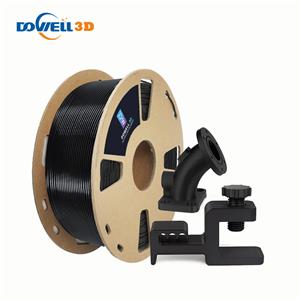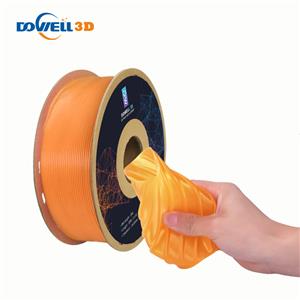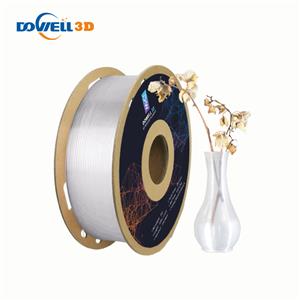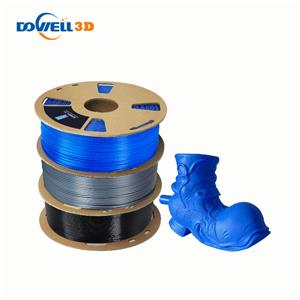How to solve the problem that the filament of the 3D printer cannot stick to the platform
How to solve the problem that the consumables of the 3D printer cannot stick to the platform
3D printing is a technology to construct objects by printing layer by layer, so no matter what parts are printed, the printed layer must be tightly adhered to the platform. Only when the bottom layer is in place, can the entire model be printed layer by layer smoothly. So, what to do if the first layer of printing fails to stick to the platform smoothly?
Possible situation 1. The construction platform is not level
Solution: Adjust the distance between the platform and the nozzle by adjusting the four spring nuts under the platform. The proper distance is about the thickness of an A4 paper from the nozzle to the platform. Turn the nozzle counterclockwise away from the platform, and turn the nozzle clockwise to solve the platform.
Note: Many printers have several screws or handles to adjust the position of the platform. If your printer has an adjustable platform and you encounter the problem that the first layer does not implant, then you first need to confirm whether your platform itself is flat and whether it is placed horizontally. If it is not level, one side of the platform will be closer to the nozzle and the other side will be too far away. For the first layer to print perfectly, it needs a level platform.
Possible situation 2. The nozzle is too far away from the platform
Solution: Adjust the spring nut under the platform to adjust the distance between the platform and the nozzle (refer to the figure below if the adjustment is appropriate)
Possible situation 3. The first layer is printed too fast
Solution: ① You can adjust the printing speed by turning the knob to the left during the printing of the first layer, and then adjust it back;
②Set the printing speed of the first layer on the slicing software (100% on the printing screen is the actual printing speed set on the slicing software, such as 50mm/s)
Explanation: When the extruder prints the first layer on the platform, you want the first layer of filament to stick properly to the surface of the platform so that other layers can be printed next. If the first layer is printed too quickly the filament may not have enough time to stick to the platform. For this reason, a very common method is to reduce the printing speed of the first layer. There is a printing speed of the bottom layer in the speed option, which can be set at 20mm/S. Sufficient printing time can make the consumables stick to the platform better, and the consumables produced are sufficient, and it is more stable for subsequent printing, and it is not easy to warp and fall off. The proper state of the first layer is that the filaments from the nozzle are in a flat state on the platform, and this effect is the most ideal.
Possible situation 4. There is a problem with the temperature or cooling settings
Solution: ①Click the knob to enter the main menu, click control, then click temperature, and set the temperature of the nozzle and hot bed to the normal range;
②PLA set nozzle temperature to 190-210 degrees, hot bed temperature to 40-50 degrees, nozzle temperature can not be set above 240 degrees, so consumables will be carbonized and cause plugging, ABS nozzle temperature to 240 degrees, hot bed temperature to 70-100 degrees.
Note: Consumables shrink when the temperature is lowered. Imagine a 100mm wide ABS plastic print, the temperature of the extruder is 230 degrees when printing, but the platform is cold, and the filament will cool rapidly after being extruded from the nozzle. Some printers also have cooling fans that, when activated, speed up the cooling process. If this ABS print, cools down to room temperature 30 degrees, this 100mm wide print will shrink 1.5mm! But the platform on your printer won't shrink that much because it's always at the same temperature. Because of this phenomenon, consumables always tend to come off the platform as they cool down. One very important factor you need to keep in mind when printing a layer, if you observe that the first layer seems to stick to the platform quickly, but then comes off as the temperature decreases, then it is most likely temperature and cooling related The problem with setting. In order to print filaments that require high temperatures to melt like ABS, many printers will have a heatable platform to deal with this. If the platform is heated during printing, and kept at around 100 degrees, it will keep the first layer hot so it won't shrink. It is generally believed that PLA will implant well when the bed is heated to between 40 and 50 degrees, while ABS is better at 60 to 70 degrees.
①You can modify this setting in the slicing software, there is a speed/temperature column in the basic;
②The temperature of the hot bed can be changed to match the conditions required by the consumables you print. This is a setting to adjust the temperature of the heated bed;
③The temperature of the hot bed can be changed to match the conditions required by the consumables you print. This is a setting to adjust the temperature of the heated bed;
Possible situation 5. Platform surface treatment (tape, glue)
Solution: 1. Stick masking paper; 2. Apply solid glue.
Note: Different consumables have different degrees of adhesion to different materials. The machine platform is made of fiberglass board, and the plane of the glass fiber board is relatively smooth. It is difficult for consumables to stick to such a smooth plane. Therefore, the following auxiliary facilities are needed to make the consumables more firmly bonded to the platform. , First of all, masking paper, there are several types of tape, which can be bonded with commonly used 3D printing filaments, strip tape can be easily adhered to the surface of the platform, and can also be easily removed or replaced to suit the printing different consumables. PLA, for example, bonds well to white masking tape (see photo below). Second, solid glue, PVP solid glue evenly coated on the glass platform can make the consumables better bonded together, and it is very convenient to clean, the solid glue is soluble in water, just wash it with water.




